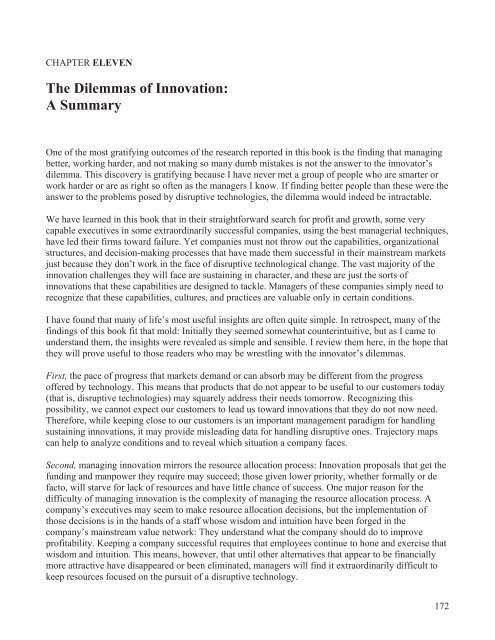PRUEBAS
PRUEBAS
PRUEBAS
You also want an ePaper? Increase the reach of your titles
YUMPU automatically turns print PDFs into web optimized ePapers that Google loves.
CHAPTER ELEVENThe Dilemmas of Innovation:A SummaryOne of the most gratifying outcomes of the research reported in this book is the finding that managingbetter, working harder, and not making so many dumb mistakes is not the answer to the innovator’sdilemma. This discovery is gratifying because I have never met a group of people who are smarter orwork harder or are as right so often as the managers I know. If finding better people than these were theanswer to the problems posed by disruptive technologies, the dilemma would indeed be intractable.We have learned in this book that in their straightforward search for profit and growth, some verycapable executives in some extraordinarily successful companies, using the best managerial techniques,have led their firms toward failure. Yet companies must not throw out the capabilities, organizationalstructures, and decision-making processes that have made them successful in their mainstream marketsjust because they don’t work in the face of disruptive technological change. The vast majority of theinnovation challenges they will face are sustaining in character, and these are just the sorts ofinnovations that these capabilities are designed to tackle. Managers of these companies simply need torecognize that these capabilities, cultures, and practices are valuable only in certain conditions.I have found that many of life’s most useful insights are often quite simple. In retrospect, many of thefindings of this book fit that mold: Initially they seemed somewhat counterintuitive, but as I came tounderstand them, the insights were revealed as simple and sensible. I review them here, in the hope thatthey will prove useful to those readers who may be wrestling with the innovator’s dilemmas.First, the pace of progress that markets demand or can absorb may be different from the progressoffered by technology. This means that products that do not appear to be useful to our customers today(that is, disruptive technologies) may squarely address their needs tomorrow. Recognizing thispossibility, we cannot expect our customers to lead us toward innovations that they do not now need.Therefore, while keeping close to our customers is an important management paradigm for handlingsustaining innovations, it may provide misleading data for handling disruptive ones. Trajectory mapscan help to analyze conditions and to reveal which situation a company faces.Second, managing innovation mirrors the resource allocation process: Innovation proposals that get thefunding and manpower they require may succeed; those given lower priority, whether formally or defacto, will starve for lack of resources and have little chance of success. One major reason for thedifficulty of managing innovation is the complexity of managing the resource allocation process. Acompany’s executives may seem to make resource allocation decisions, but the implementation ofthose decisions is in the hands of a staff whose wisdom and intuition have been forged in thecompany’s mainstream value network: They understand what the company should do to improveprofitability. Keeping a company successful requires that employees continue to hone and exercise thatwisdom and intuition. This means, however, that until other alternatives that appear to be financiallymore attractive have disappeared or been eliminated, managers will find it extraordinarily difficult tokeep resources focused on the pursuit of a disruptive technology.172


